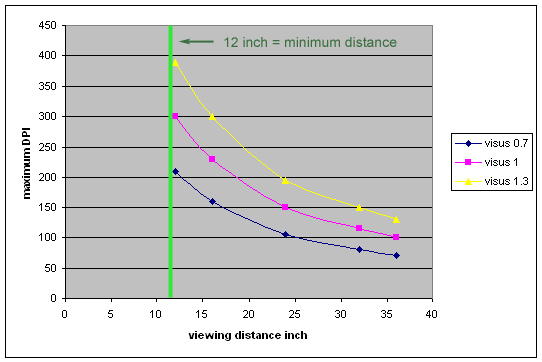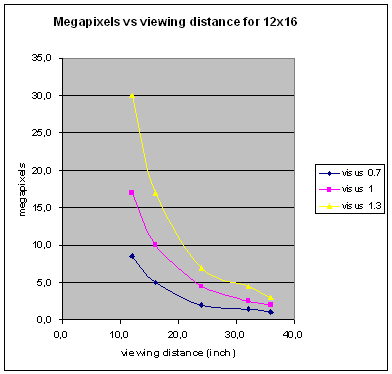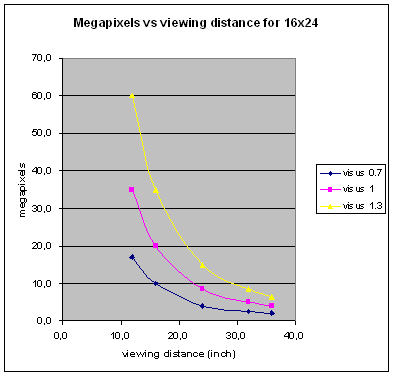Perception of Print quality
Maybe a strange question; How good are your eyes?
Conclusion.
Ther are big differences between eyes, an overlooked item in photography. Because of these differences people will see the same print in a different way, more or less sharp. It can give a lot of confusion.
A lot of people with below average eyes will see a 12x16 print with only 6 megapixel as sharp. Someone with better eyes will see this print as allmost sharp. This viewer would appreciate 30 megapixel instead of 6 megapixel.
Comparison prints of different cameras
How many pixels are there really on a print .
In the world of prints these days everybody is speaking about dpi or ppi to state the quality of the print. This is indeed a very important factor for the quality. One important issue everybody forgets is that prints are made for human beings. The quality of the eye is measured as the ability to distinguish points. In literature the sharpness of the eye is normalized as 1/60 of a degree, this is called a visus of 1. The standard of 300 dpi is sharp enough for this visus, with normal eyes a 300 dpi print should look sharp.
But is this true? What about people with better or less than average eyes. Do they all need the same print quality.?
Distance.
The closer we come the more we can see. Althoug at a certain distance, below 12 inch (30 cm) it is no longer conveniant to look at prints. Big prints, like 16x24 inch (40x50 cm) are normally viewed at a greater distance. This size can be used for a gallery or a wall at home.
Normally a big print like that is seen at a distance of more than 12 inch (30 cm). But especially with fine art, landscape, it should be possible to see it at a smaller distance. That way we can see alle the fine details. Generally speaking, prints will be viewed between 12-40 inch. (30-100 cm), depending on the subject.
Older people have more problems to view at close distance. The normal viewing distance of 12 inch (30 cm ) is too close for them. 16 inch (40cm) should be better for them. That's why elderly peoply probably see less sharp in comparison with young people. Although their visus can still be good, and maybe above average, because their viewing distance is normally 16 inch or more, as a result of this, they see less detail.
Viewing conditions.
The eye is much less sensitive at lower lighting levels. In a gallery there is a lot of light, about 250-500 lux, with good spectral quality. At home most of the time the lighting levels are lower. Not many people have the amount of light at home of a gallery! This willl do no good for the amount of pixels we can actually see. With light levels of 500 lux the aperture of the eye is small and we have maximum sharpness.
Vision, Eye quality.
- Normal eyes have a resolution of 1/60 of a degree. Visus = 1
- Below average eyes have a resolution (visus) lower than 1 . A visus of 0.6 is considered to be the limit for driving a car. In fact that is very low.
- Above average eyes have a resolution (visus) higher than 1, a visus of 1.3 is considered very good.
The distribution of human eye quality is like a normalized bell curve. So for everyone with above average eyes, there is someone with below average eyes. It is not clear if among photographers a larger percentage has above average eyes. You should expect it but no research is done. Here you can test your own eyes .
But among the viewers of your pictures there should be a fairly large percentage (about 50 percent) who have below average eyes.
Some facts.
- To drive a car you need a minimum visus of 0.6- 0.7
- A pilot of an aeroplane should have a visus of minimum of 1.5
- Older people have a little lower visus than younger people. But generally speaking the visus will not degrade too much with the growing of years. Of course when there is an illness of the eye the visus will degrade dramatically.
Visus related to DPI of prints
If we consider a visus of 1 (normal eyes) we can see about 300 pixels/inch at a viewing distance of 12 inch (30 cm ) It is of course no coincidence that most laserprinters like a Fuji Frontier are 300 dpi.
Perception of sharpness.
The table below gives the average amount of pixels one need to view a print of a certain dimension depending on the quality of the viewers eye.

Maximum DPI for different viewing distances at a certain visus
It is easy to see that with good eyes, visus = 1.3 or above 400 dpi can be seen on a normal viewing distance. The maximum for people with less visus (0,7) is about 200 dpi.
| visus |
maximum visible dpi related to viewing distance inch (cm.)
|
||||
| 12 (30) | 16 (40) | 24 (60) | 32 (80) | 36 (90) | |
| 0,7 | 210 dpi | 160 | 105 | 80 | 70 |
| 1 | 300 dpi | 230 | 150 | 115 | 100 |
| 1,3 | 390 dpi | 300 | 195 | 150 | 130 |

At a viewing distance of 12 inch, you need 30 megapixels to produce a sharp 12x16 print for people with a high visus of 1.3 (20% of population)
The same print with 8.5 megapixels looks very sharp for people with a visus of 0.7 at the same distance. (20% world population)
|
viewing distance in inch (cm.)
|
|||||
| 12 (30) | 16 (40) | 24 (60) | 32 (80) | 36 (90) | |
| visus | |||||
| 0,7 |
8,5
|
5,0 | 2,0 | 1,5 | 1,0 |
| 1 | 17,0 | 10,0 | 4,5 | 2,5 | 2,0 |
| 1,3 | 30,0 | 17,0 | 7,0 | 4,5 | 3,0 |

For a 16 x 24 gallery print you need 60 megapixel to produce a sharp print for the 20% of the people who have a visus of 1.3
Because of the larger viewing distance for this bigger prints you can also use something between 15-35 megapixel for the 1.3 visus viewers.
|
Viewing distance in inch (cm)
|
|||||
| 12 (30) | 16 (40) | 24 (60) | 32 (80) | 36 (90) | |
| visus | |||||
| 0,7 | 17,0 | 10,0 | 4,0 | 2,5 | 2,0 |
| 1 | 35,0 | 20,0 | 8,5 | 5,0 | 4,0 |
| 1,3 | 60,0 | 35,0 | 15,0 | 8,5 | 6,5 |
The eye quality will be distributed among all people like a normalized bell curve. So it is save to assume that approximately 90% of all people are between a visus of 0.7 and 1.3. The implications are dramatically.
When testing photographic equipment it is very important that the person who is doing the evaluation of print sharpness, is aware of his/her own visus or eye quality. A subjective discussion, about lens or print quality, without measured testresults, has not much practical use until you know the quality of the eyes of the testperson.
Probably this is the reason that a lot of photographers are very happy with their Epson inkjet printers, like the 2200 or the 4000. However these printers will not give you more than about 225 ppi. The prints look beautifull but the same print on a Fuji Frontier with 300 dpi looks clearly more sharp.
25-40 percent of all the people cannot see the difference between an Epson 2200 print and a good 300 dpi print. Of course that is not a problem but it is important to know if these are the same people who tell you that this printer is really sharp. Maybe you have better eyes and can see a difference with a Durst at 400dpi.
Kodak and Durst make some printers with 400 dpi capabilities. If you have good eyes than you will be pleased with the sharpness, crispness of the prints they can produce, but even a 300 dpi Frontier print can be very sharp.
The digital camera test
The ongoing discussion about the quality of digital camera's.
According to a testperson there is almost nodifference between a 12mp DSLR and a medium format. But of course this can be largely due to differences in eyes and visus.
Comparison between medium format and Nikon D2x or Canon 1ds
In a comparison between a 12mp DSLR D2x and a medium format an imaginary testperson concludes there is no significant difference on a print of 24x32 inch. Yes the digital looks even better.
Why ? The print is probably printed on an Epson 4000 with 200-225 ppi, the maximum obtainable ppi (dpi) with this printer. If the testperson has eyes with a visus of 0.7 (not uncommon) than the print will use 10-18 megapixel at a viewing distance of 12-16 inch (30-40cm). The 12 megapixel digital will deliver something between but will look very sharp at this distance.
The medium camera has even more resolution, maybe 30 megapixel but will look the same for him. His eyes (visus 0.7) cannot see any difference, even at 12 inch (30 cm) distance. For this viewer both pictures will look completely the same when printed. So, completely honest he will report this to us. A lot of people who buy the same camera will notice the same (they also have a visus of 0.7). In the newsgroups you will see their unbelievable testing result with very large prints.
However, when another person with a visus of 1.3 will see the same test prints the conclusion will be completely different. This person will report a big difference. At 12 inch (30cm.) viewing distance he can see 45 megapixel. The 12 megapixel of the digital will be much worse. Probably he will report something like ' medium format is much better than digital, digital can never compete with anolog etc etc.' The war in the newsgroups will start again....
Both are true and honest. 20-30% of mankind can see the same. The rest will never notice it ....
you can read my comparison between the Mamiya 7 and the Nikon D2x also.
How to measure your own eyes.
You should measure your own eyes. You need a card with Landolt rings. You can find a copy here. Just print it and test your own eyes at 4 meter distance. Be carefull to print it the right size, no fit to page in Adobe. Sehscharfe is German for visus.
At the eye clinic at Freiburg , Germany, eyeresearch, elektrophysiology you have a very nice electronic eye test you can do with your monitor.
